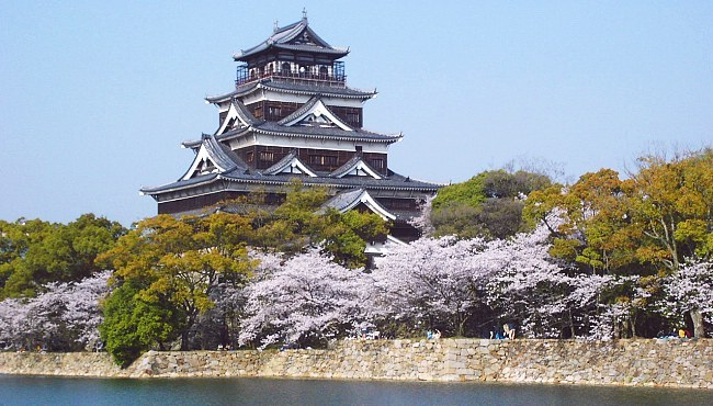I’m flying premium economy to Osaka. It feels like an aviation value pick. You avoid the discomforts of economy without paying for the excesses of business class.
The small cabin is about 60% filled, mostly with older returning Japanese. And the larger business class section ahead is similarly stocked.
This is a good sign for the Japanese economy. It’s a country mired in the unwinding of a share market bubble. Up to its eyeballs in public debt and grappling with needed tax rises to pay for a fast-ageing populace.
As it stands, the annual tax take cannot keep up with the interest bill. And with a median age over 48, the country is running out of younger taxpayers.
Life in Japan
Trust me, if you want to feel young, spend some time in a Japanese park. Walking canes are the norm. But so too is friendliness.
As I stop to look at an old bent-over tree at Hiroshima Castle, an elderly lady stops to tell me about it. It has been more than 20 years since I lived in Japan. So I can only make out a little of her Japanese. But I get the gist: this tree survived the 1945 atomic bomb.
I thank her. And follow her in touching the wood. To avoid any market bomb. For longevity.

Hiroshima Castle. Source: Japan Guide
Yet, when it comes to the share market, many of Japan’s retirees are scared stiff.
The 30-year Japanese market crash
The Japanese market decompression since its high of 1989 resembles the New Zealand market in 1987. Back then, many Japanese (and NZX) shares were trading at P/E ratios of over 60 — compared to a global norm of 14 to 16.
Unlike the Kiwi crash of ‘87 — which was sudden and then led to recovery — the Japanese crash lasted 30 years, falling some 40% from the 1989 peak until today.
Indeed, there’s a valuable lesson in paying too much for assets. Yet, for Japanese retail investors, few have shown signs of wanting to get back in. They were burnt once and do not want to go near the fire again.
But the fire could be safe now, with the average Japanese stock trading at a discount of 20% on the average European stock. Which in turn trades at a discount of 20% on the average US stock.
There’s been a long slow burn on the Japanese market. Not the sort of bomb crash and recovery we see in the West.
Could Japan be our next Brexit value zone?
For readers who follow our Lifetime Wealth Investor portfolio, you’ll have seen some generous profits from our UK macro strategy over the past 6 months.
It seems Japan sits in a similar value range with the end of the tunnel nigh. Stocks show signs of recuperating — up about 20% last year. Could now be the time to get in?
Life support
Prime Minister Shinzō Abe has a quantitative-easing plan (Abenomics). And under this, the Bank of Japan (the central bank) will soon become the top holder of the nation’s stocks through its market-buying programme. This is adding market impetus.
Japan is an economy on life support. High debt. Low interest rates. An ageing society. The government is attempting to shore up asset prices and get people spending to stave off the spectre of deflation.
You buy into this weakness — but also opportunity — at your risk.
Still, Japan remains the world’s third-largest economy. It’s a powerhouse of industrial exports and technological potential.
The golden opportunity
Spend any length of time here, and you’ll enjoy the efficiency and comfort of Japan’s innovations. From heated toilets that will wash and dry your nether regions, to shower rooms that can dry you and your clothes, to public transport networks that are the envy of the world.
As China gets a second wind with warming US trade negotiations, demand for Japan’s machinery and high-tech components may increase.
There are Japanese companies whose stock prices sit in value territory and could benefit. We will be covering such opportunities in our Lifetime Wealth Investor research.
The road ahead for Japan
With 30 years of market anxiety and suppressed wages, the other benefit in investing in Japan comes down to income.
Many Japanese companies have chosen to share their business growth with stock holders, not employees. This means there are often strong lines of dividend income besides the growth potential.
From 2000 to 2018, labour costs rose only 3% — but dividends jumped 440%.
Is it time to get on the train as an investor?
For now, I have another train to catch. A Shinkansen (bullet train) from Hiroshima to Osaka. It is time to head east toward the industrial heartland of Japan.
In search of opportunity.
Regards,
Simon Angelo
Editor, WealthMorning.com





Simon is the Chief Executive Officer and Publisher at Wealth Morning. He has been investing in the markets since he was 17. He recently spent a couple of years working in the hedge-fund industry in Europe. Before this, he owned an award-winning professional-services business and online-learning company in Auckland for 20 years. He has completed the Certificate in Discretionary Investment Management from the Personal Finance Society (UK), has written a bestselling book, and manages global share portfolios.